Understanding Beat Sheets in Screenwriting: A Beginner’s Guide
Screenwriting is an art that combines creativity with structure to tell compelling stories. One of the key tools in the screenwriter’s toolkit is the beat sheet. For beginners venturing into the world of screenwriting, understanding beat sheets and their role in the storytelling process can be a game changer.
What is a Beat Sheet?
A beat sheet is a type of outline used by screenwriters to plan the structure of a screenplay. It breaks down the narrative into individual beats or significant story points. These beats represent key moments in the storyline that propel the narrative forward, shaping the pacing and emotional arc of the script. Essentially, a beat sheet is a roadmap for the screenwriter, detailing what happens, when it happens, and why it is important for the overall story.
Why Use Beat Sheets?
Beat sheets offer numerous benefits to screenwriters, especially to those just starting their journey. They provide a clear framework that can help manage the complex elements of storytelling, ensuring that the narrative maintains momentum and coherence. By outlining the major beats of the story, writers can visualize the beginning, middle, and end of their screenplay, making it easier to identify potential pacing issues or plot holes early in the writing process. Moreover, beat sheets encourage creativity within structure, enabling writers to experiment with story elements while keeping the narrative on track.
Basic Components of a Beat Sheet
While each story is unique, and beat sheets can be adapted to fit various narrative structures, there are common components found in most beat sheets:
- Opening Image: A visual that sets the tone, theme, or world of the story.
- Inciting Incident: An event that disrupts the protagonist’s world, thrusting them into the story’s main conflict.
- First Act Break: A turning point that concludes the setup of the story and leads into the confrontation.
- Midpoint: A moment that changes the direction or raises the stakes of the story, often deepening the conflict.
- Second Act Break: Another turning point that concludes the confrontation phase and sets up the story’s resolution.
- Climax: The peak of the story where the protagonist faces the main conflict.
- Final Image: The last image or scene that leaves a lasting impression, often reflecting how the characters or world have changed.
Creating Your Own Beat Sheet
Starting with a beat sheet can be as simple as jotting down the key events you envision for your story, then expanding on these points with more detail. Many screenwriters begin with the components listed above, tailoring them to fit the unique needs of their narrative. It’s important to remember that a beat sheet is a flexible tool; it should serve your creative process, not restrict it. Play around with the order and nature of your beats. Sometimes, discovering the structure that best suits your story is a journey in and of itself.
Conclusion
Understanding and utilizing beat sheets in screenwriting are crucial steps for beginners. They offer a foundation for structuring your screenplay, ensuring your narrative flows smoothly from the opening scene to the final image. While the creation of a beat sheet may initially seem daunting, its benefits to the storytelling process are invaluable. By breaking down your narrative into manageable beats, you can craft a compelling screenplay that captivates audiences and leaves a lasting impact.






